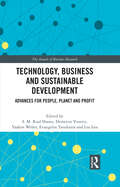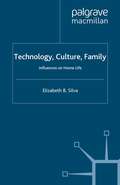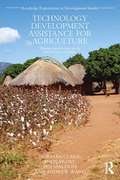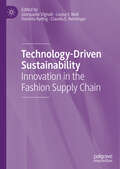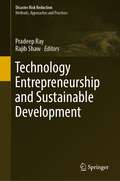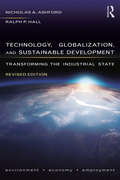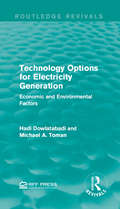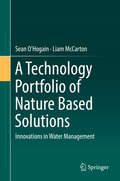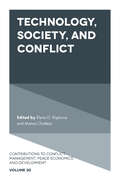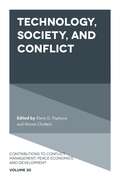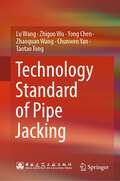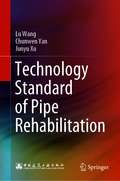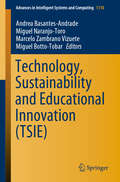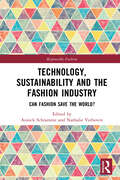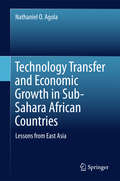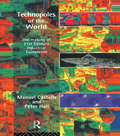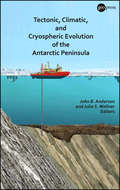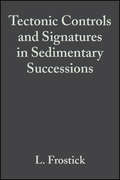- Table View
- List View
Technology, Business and Sustainable Development: Advances for People, Planet and Profit (The Annals of Business Research)
by Shams, S. M. Riad Demetris Vrontis Yaakov Weber Evangelos Tsoukatos Lea IaiaTriple bottom line (TBL or 3BL) was coined as a wide and inspiring approach for businesses aimed at understanding how to create, track, and manage economic, social, and environmental values added. The sustainability sector is strongly increasing its relevance among academics and practitioners, and the market opportunities associated with the sustainable development goals (SDGs) are estimated at over $ 12 trillion per year by 2030. Although this is a promising context, a recent article suggested a rethinking of the TBL, arguing that sustainability goals’ value should not be assessed in terms of profit and loss but of people well-being and planet health, looking for a societal profit. Technology plays a crucial role in our society. Respectively, the Agenda 21 and the Paris Agreement consider technology to be essential in the pursuit of sustainable development and the achievement of the SDGs. Adding to this, the Covid-19 pandemic has accelerated the adoption of digital solutions in several fields, from the way of working to the way of buying and consuming. Companies are becoming more aware of the responsibility they have within environmental and human contexts, and people are looking for work reflecting their values and purposes to motivate them. This book aims to contribute to the understanding of the role of technology and its emerging and innovative solutions in the achievement of sustainable development while making a profit. It will be of value to researchers, academics, practitioners, and students in the fields of strategic management, entrepreneurship, management of technology and innovation, and sustainable development.
Technology, Business and Sustainable Development: Advances for People, Planet and Profit (The Annals of Business Research)
Triple bottom line (TBL or 3BL) was coined as a wide and inspiring approach for businesses aimed at understanding how to create, track, and manage economic, social, and environmental values added. The sustainability sector is strongly increasing its relevance among academics and practitioners, and the market opportunities associated with the sustainable development goals (SDGs) are estimated at over $ 12 trillion per year by 2030. Although this is a promising context, a recent article suggested a rethinking of the TBL, arguing that sustainability goals’ value should not be assessed in terms of profit and loss but of people well-being and planet health, looking for a societal profit. Technology plays a crucial role in our society. Respectively, the Agenda 21 and the Paris Agreement consider technology to be essential in the pursuit of sustainable development and the achievement of the SDGs. Adding to this, the Covid-19 pandemic has accelerated the adoption of digital solutions in several fields, from the way of working to the way of buying and consuming. Companies are becoming more aware of the responsibility they have within environmental and human contexts, and people are looking for work reflecting their values and purposes to motivate them. This book aims to contribute to the understanding of the role of technology and its emerging and innovative solutions in the achievement of sustainable development while making a profit. It will be of value to researchers, academics, practitioners, and students in the fields of strategic management, entrepreneurship, management of technology and innovation, and sustainable development.
Technology, Culture, Family: Influences on Home Life (Palgrave Macmillan Studies in Family and Intimate Life)
by E. SilvaThis book examines connections between personal, relational and material matters in everyday life in the context of broader and long standing social problems. It explores the connections between mundane practices in the reproduction of our bodies and our relations with those we live with, and the technological practices that inform daily life.
Technology Development Assistance for Agriculture: Putting research into use in low income countries (Routledge Explorations in Development Studies)
by Norman Clark Andy Frost Ian Maudlin Andrew WardStemming from an 11-year DFID funded programme under its Renewable Natural Resources Research Strategy (RNRRS), Technology Development Assistance for Agriculture: Putting Research into Low Income Countries reviews part of this programme as a case study of a broader issue of technology development for Africa. Controversially, it critiques current international technology development assistance and focuses on the potential role of the private sector in agricultural technology development as well as providing insights for future cognate science policy and practice. The book focuses on the RIU "Best Bets" Africa sub-programme. This identified promising proposals to take existing agriculture research products and put these into use in ways that would benefit the poor in developing countries. The sum set aside for this was £5 million. The empirical sections of the book cover project selection, progress and programme management over a 2009-2012 period with special attention paid to lessons learned that may have implications for future cognate technology development assistance. This topical book gives direct evidence of meeting objectives and delivering real changes in technology development for Africa to postgraduate students, researchers, international bodies, NGOs, policy makers and government organisations working on natural resource management, technology development assistance, and low income country agriculture.
Technology Development Assistance for Agriculture: Putting research into use in low income countries (Routledge Explorations in Development Studies)
by Norman Clark Andy Frost Ian Maudlin Andrew WardStemming from an 11-year DFID funded programme under its Renewable Natural Resources Research Strategy (RNRRS), Technology Development Assistance for Agriculture: Putting Research into Low Income Countries reviews part of this programme as a case study of a broader issue of technology development for Africa. Controversially, it critiques current international technology development assistance and focuses on the potential role of the private sector in agricultural technology development as well as providing insights for future cognate science policy and practice. The book focuses on the RIU "Best Bets" Africa sub-programme. This identified promising proposals to take existing agriculture research products and put these into use in ways that would benefit the poor in developing countries. The sum set aside for this was £5 million. The empirical sections of the book cover project selection, progress and programme management over a 2009-2012 period with special attention paid to lessons learned that may have implications for future cognate technology development assistance. This topical book gives direct evidence of meeting objectives and delivering real changes in technology development for Africa to postgraduate students, researchers, international bodies, NGOs, policy makers and government organisations working on natural resource management, technology development assistance, and low income country agriculture.
Technology-Driven Sustainability: Innovation in the Fashion Supply Chain
by Claudia E. Henninger Daniella Ryding Gianpaolo Vignali Louise F. ReidThis book provides a critical overview of technologies that are used within the fashion industry and supply chain, with a special emphasis on how they engender sustainability and the circular economy. The chapters present contemporary case studies alongside new research on technologies such as 3D printing, 3D scanning and recycling technology to assess the effect they will have on the future of fashion and its global supply chain.
Technology Entrepreneurship and Sustainable Development (Disaster Risk Reduction)
by Pradeep Ray Rajib ShawThis book discusses the need for entrepreneurship for sustainable development from the perspective of Asia, the fastest growing region in the world. The world is now witnessing a spectacular rise of technology entrepreneurship, involving mobile phones, artificial intelligence, geospatial information systems and social media. On the other hand, governments all over the world, particularly those in low and medium income countries, are facing severe resource constraints in developing the livelihood and well-being of citizens. Although many non-government organizations (NGOs) have worked on various development projects in a number of social sectors such as health, education, disabilities, poverty alleviation and environment, there is still substantial scope for technological innovation, including more efficient, effective and user-friendly solutions in different parts of the world. This book is organized into 2 parts and consists of 17 chapters. The first part explores education and well-being, and the second part discusses the climate, environment and disaster management.
Technology, Globalization, and Sustainable Development: Transforming the Industrial State
by Nicholas A Ashford Ralph P HallTechnology, Globalization, and Sustainable Development offers a unified, transdisciplinary approach for transforming the industrial state in order to promote sustainable development. The authors present a deep analysis of the ways that industrial states – both developed and developing – are currently unsustainable and how economic and social welfare are related to the environment, to public health and safety, and to earning capacity and meaningful and rewarding employment. The authors offer multipurpose solutions to the sustainability challenge that integrate industrial development, employment, technology, environment, national and international law, trade, finance, and public and worker health and safety. The authors present a compelling wake-up call that warns of the collision course set between the current paths of continued growth and inevitable unsustainability in the world today. Offering clear examples and real solutions, this textbook illustrates how the driving forces that are currently promoting unsustainability can be refocused and redesigned to reverse course and improve the state of the world. This book is essential reading for those teaching and studying sustainable development and the critical roles of the economy, employment, and the environment.
Technology, Globalization, and Sustainable Development: Transforming the Industrial State
by Nicholas A Ashford Ralph P HallTechnology, Globalization, and Sustainable Development offers a unified, transdisciplinary approach for transforming the industrial state in order to promote sustainable development. The authors present a deep analysis of the ways that industrial states – both developed and developing – are currently unsustainable and how economic and social welfare are related to the environment, to public health and safety, and to earning capacity and meaningful and rewarding employment. The authors offer multipurpose solutions to the sustainability challenge that integrate industrial development, employment, technology, environment, national and international law, trade, finance, and public and worker health and safety. The authors present a compelling wake-up call that warns of the collision course set between the current paths of continued growth and inevitable unsustainability in the world today. Offering clear examples and real solutions, this textbook illustrates how the driving forces that are currently promoting unsustainability can be refocused and redesigned to reverse course and improve the state of the world. This book is essential reading for those teaching and studying sustainable development and the critical roles of the economy, employment, and the environment.
Technology Options for Electricity Generation: Economic and Environmental Factors (Routledge Revivals)
by Hadi Dowlatabadi Michael A. TomanEnvironmental constraints and market uncertainties create new challenges for electricity generation. In this title, originally published in 1991, the authors present a simulation model with a capability for highly detailed activity to identify cost-minimising investment options under different assumptions about demand, costs, regulation, and other economic and environmental factors. Applying the model to two U.S. regions having sharply different electricity demand and supply characteristics, they identify the importance of advanced technologies and augmented electricity trade among regions. This title is ideal for students interested in environmental studies.
Technology Options for Electricity Generation: Economic and Environmental Factors (Routledge Revivals)
by Hadi Dowlatabadi Michael A. TomanEnvironmental constraints and market uncertainties create new challenges for electricity generation. In this title, originally published in 1991, the authors present a simulation model with a capability for highly detailed activity to identify cost-minimising investment options under different assumptions about demand, costs, regulation, and other economic and environmental factors. Applying the model to two U.S. regions having sharply different electricity demand and supply characteristics, they identify the importance of advanced technologies and augmented electricity trade among regions. This title is ideal for students interested in environmental studies.
A Technology Portfolio of Nature Based Solutions: Innovations in Water Management
by Sean O'Hogain Liam McCartonThis book aims to define the concept of Nature Based Solutions (NBS) by using case studies from members of the European Innovation Partnership (EIP) Water Action Group - NatureWat. NBS is defined and characterized in terms of water source, contaminants, removal mechanisms and resource recovery potential. The case studies presented illustrate the appropriateness of NBS promoting climate resilience. Readers will discover a technology portfolio based on a number of demonstration sites in the fields of climate change adaption, water and wastewater treatment, resource recovery and re-use, and restoring ecosystems to promote the use of nature based solutions. The chapters in the book present a multidisciplinary approach involving social scientists, governance representatives and engineers. The underlying philosophy of the book is the circular economy of water which prioritizes the concepts of resource recovery and resilience within water resource management. The first section of the book presents the background and objectives of the study, and how the action group aims to promote the use of nature based solutions through its diverse technology portfolio. Particular attention is given to the goals of finding cost-effective solutions for wastewater treatment, climate change mitigation, disaster risk reduction, flood protection, greening cities, degraded areas restoration and biodiversity preservation. The chapter on reclaimed water addresses water reuse and defines the term fit for purpose. Barriers and limitations related to NBS for water resource management are discussed. The book concludes with several case studies at local, regional and global levels which illustrate a new approach to water management. These case studies illustrate the application of a hybrid green and grey infrastructure system. This is a combination of traditional engineered infrastructure with nature based solutions which combines centralised and decentralised systems to optimise the reclamation of water for reuse in a fit for purpose model.
Technology, Society, and Conflict (Contributions to Conflict Management, Peace Economics and Development #30)
by Elena G. Popkova, Manas ChatterjiTechnology, Society, and Conflict comprehensively studies and systematically highlights technological inequalities as a source of conflict in digital development while developing an economic and legal approach to resolving them. With a progressive approach, chapters reveal the social nature of technological inequality and digital development conflicts and model them as social institutions. The conflicts of digital development are identified and analysed in detail: global conflict of the technological inequality in the modern world economy; gender conflict; conflict in the labour market in the context of automation based on Robots, Big Data, and AI; and conflict in international trade. The manifestations of the digital divide are considered based on international practical experience at all levels of management – country, regional, business and household levels. This 30th volume of Contributions to Conflict Management, Peace Economics, and Development gives special attention to the latest experience in technological inequality and the aggravation of digital development conflicts in the context of the COVID-19 pandemic and crisis in 2019-2020 with foresight for the post-pandemic period.
Technology, Society, and Conflict (Contributions to Conflict Management, Peace Economics and Development #30)
by Elena G. Popkova Manas ChatterjiTechnology, Society, and Conflict comprehensively studies and systematically highlights technological inequalities as a source of conflict in digital development while developing an economic and legal approach to resolving them. With a progressive approach, chapters reveal the social nature of technological inequality and digital development conflicts and model them as social institutions. The conflicts of digital development are identified and analysed in detail: global conflict of the technological inequality in the modern world economy; gender conflict; conflict in the labour market in the context of automation based on Robots, Big Data, and AI; and conflict in international trade. The manifestations of the digital divide are considered based on international practical experience at all levels of management – country, regional, business and household levels. This 30th volume of Contributions to Conflict Management, Peace Economics, and Development gives special attention to the latest experience in technological inequality and the aggravation of digital development conflicts in the context of the COVID-19 pandemic and crisis in 2019-2020 with foresight for the post-pandemic period.
Technology Standard of Pipe Jacking
by Lu Wang Zhiguo Wu Yong Chen Zhaoquan Wang Chunwen Yan Taotao TongThis book summarizes the technical method and construction process of pipe jacking. It has a total of 17 chapters and one appendix. It includes how to prepare the pipe jacking construction, how to choose the pipe and equipment for jacking, how to choose the engineering environment, how to do the geological survey before jacking, how to design the working pit, what's the procedure of pipe jacking, how to do the measurement and monitoring during jacking, how to do the treatment and acceptance after jacking, and so on. Appendix contains reference tables for pipe jacking archives, which might aid readers in understanding the book's content. This book's language is simple to read, and it has a wealth of graphics. Even those without a foundational understanding of pipe jacking could read and comprehend it with ease. This regulation could be the fundamental discipline for pipeline jacking projects. It is the important basis and criterion for the design, construction, management, inspection, and acceptance of pipeline jacking.
Technology Standard of Pipe Rehabilitation
by Lu Wang Chunwen Yan Junyu XuThis book summarizes the technical method and construction process of underground pipeline testing, cleaning, updating and repairing. It has 20 chapters and an appendix in total. Its content includes: Pipeline rehabilitation construction organization design, Pipeline cleaning, Preparations before construction, Pipeline detection and quality assessment, Pipeline rehabilitation design/method/equipment selection/steps/technical indicators, Pipe Cracking & Bursting method, Sliplining method, Pipe Segments Method, Lining with Inserted hose(improved) method, Cured in place pipe(CIPP), Spray lining, Spiral winding method, Spot repair method, universal construction techniques, construction of general rules, the engineering quality acceptance, construction health, safety, environmental protection and production management, and so on. The appendix is the interpretation for the relevant technical terms in this book. It could help the reader who doesn’t have the basic knowledge about pipe rehabilitation to understand this technology easily. This regulation could be the fundamental discipline for pipeline renewal projects in different industries. It could provide the important basis and criterion for design, construction, management, inspection and acceptance of pipeline renewal projects.
Technology, Sustainability and Educational Innovation (Advances in Intelligent Systems and Computing #1110)
by Andrea Basantes-Andrade Miguel Naranjo-Toro Marcelo Zambrano Vizuete Miguel Botto-TobarThis book presents the proceedings of International Conference on Knowledge Society: Technology, Sustainability and Educational Innovation (TSIE 2019). The conference, which was held at UTN in Ibarra, Ecuador, on 3–5 July 2019, allowed participants and speakers to share their research and findings on emerging and innovative global issues. The conference was organized in collaboration with a number of research groups: Group for the Scientific Research Network (e-CIER); Research Group in Educational Innovation and Technology, University of Salamanca, Spain(GITE-USAL); International Research Group for Heritage and Sustainability (GIIPS), and the Social Science Research Group (GICS). In addition, it had the endorsement of the RedCLARA, e-science, Fidal Foundation, Red CEDIA, IEEE, Microsoft, Business IT, Adobe, and Argo Systems. The term “knowledge society” can be understood as the management, understanding and co-creation of knowledge oriented toward the sustainable development and positive transformation of society. In this context and on the occasion of the XXXIII anniversary of the Universidad Técnica del Norte (UTN), the Postgraduate Institute through its Master of Technology and Educational Innovation held the I International Congress on Knowledge Society: Technology, Sustainability and Educational Innovation – TSIE 2019, which brought together educators, researchers, academics, students, managers, and professionals, from both the public and private sectors to share knowledge and technological developments. The book covers the following topics: 1. curriculum, technology and educational innovation; 2. media and education; 3. applied computing; 4. educational robotics. 5. technology, culture, heritage, and tourism development perspectives; and 6. biodiversity and sustainability.
Technology, Sustainability and the Fashion Industry: Can Fashion Save the World? (Responsible Fashion)
by Annick Schramme Nathalie VerbovenThere is widespread rhetorical agreement that the fashion industry must get itself onto a more sustainable footing. What does this mean in practice, and how can sustainability be achieved in different regions around the world? This book brings together expert scholars and reflective practitioners via a network of dialogue and exchange to help drive forward a sustainable future for the fashion industry. With a focus on technological innovation, the contributions to this book provide a range of case studies from design thinking, through digital clothing and inclusive fashion. This book will be of interest to researchers and scholars in the fields of circular business and the fashion industry, and provides a unique resource for readers seeking to understand more about the need for responsible fashion and how technology might be able to help.
Technology, Sustainability and the Fashion Industry: Can Fashion Save the World? (Responsible Fashion)
There is widespread rhetorical agreement that the fashion industry must get itself onto a more sustainable footing. What does this mean in practice, and how can sustainability be achieved in different regions around the world? This book brings together expert scholars and reflective practitioners via a network of dialogue and exchange to help drive forward a sustainable future for the fashion industry. With a focus on technological innovation, the contributions to this book provide a range of case studies from design thinking, through digital clothing and inclusive fashion. This book will be of interest to researchers and scholars in the fields of circular business and the fashion industry, and provides a unique resource for readers seeking to understand more about the need for responsible fashion and how technology might be able to help.
Technology Transfer and Economic Growth in Sub-Sahara African Countries: Lessons from East Asia
by Nathaniel O. AgolaThis book provides a pragmatic analytical model grounded on the solid idea that technologies and the accompanying implementation efforts only make sense if they are successfully deployed in markets. The analytical model also provides an exhaustive analysis of all critical variables at the global, regional and national levels, which contribute to failure or success of technology transfer efforts. The model is validated by an incisive analysis of technology transfer experiences of Japan, Korea, Singapore, Taiwan (province of China), and Malaysia. While this book finds that these East Asian countries have had both diverging and converging models, and experiences with technology transfer, the enduring and fundamental aspects of technology transfer in specific industrial sectors and economic growth in these countries is then used to draw lessons for African countries.This book therefore is a timely and compelling piece of research work that provides valuable answers to the increasingly urgent question of how African countries can industrialize through technology transfer to meet their economic development and growth ideals.
Technopoles of the World: The Making of 21st Century Industrial Complexes
by Manuel CastellsTechnopoles - planned centres for the promotion for high- technology industry - have become a key feature of national economic development worldwide. Created out of a technological revolution, the formation of the global economy and the emergence of a new form of economic production and management, they constitute the mines and foundries of the information age, redefining the conditions and processes of local and regional development. This book is the first systematic survey of technopoles in all manifestations: science parks, science cities, national technopoles and technobelt programmes. Detailed case studies, ranging from the Silicon Valley to Siberia and from the M4 Corridor to Taiwan, relate how global technopoles have developed, what each is striving to achieve and how well it is succeeding. Technopoles of the World distills the lessons learnt from the successes and failures, embracing a host of disparate concepts and a few myths, and offering guidelines for national, regional and local planners and developers worldwide.
Technopoles of the World: The Making of 21st Century Industrial Complexes
by Manuel CastellsTechnopoles - planned centres for the promotion for high- technology industry - have become a key feature of national economic development worldwide. Created out of a technological revolution, the formation of the global economy and the emergence of a new form of economic production and management, they constitute the mines and foundries of the information age, redefining the conditions and processes of local and regional development. This book is the first systematic survey of technopoles in all manifestations: science parks, science cities, national technopoles and technobelt programmes. Detailed case studies, ranging from the Silicon Valley to Siberia and from the M4 Corridor to Taiwan, relate how global technopoles have developed, what each is striving to achieve and how well it is succeeding. Technopoles of the World distills the lessons learnt from the successes and failures, embracing a host of disparate concepts and a few myths, and offering guidelines for national, regional and local planners and developers worldwide.
Tectonic, Climatic, and Cryospheric Evolution of the Antarctic Peninsula (Special Publications #63)
by John B. Anderson Julia S. WellnerPublished by the American Geophysical Union as part of the Special Publications Series. Tectonic, Climatic, and Cryospheric Evolution of the Antarctic Peninsula presents the analysis of data collected during the SHALDRIL program, which sampled the most complete Cenozoic stratigraphic section in the Antarctic Peninsula. The stratigraphic intervals sampled fill major gaps in the existing stratigraphic record in the region, which is believed to have been the last place in Antarctica to become fully glaciated and, as such, the last refugium for plants and animals living on the continent. Providing previously unpublished results from studies aimed at improving our understanding of the changes in climate, glacial setting, and fauna and flora that took place over the past 30 million years, the volume highlights include discussions of marine seismic and drill core records documenting the initial growth and expansion of an ice sheet across the northernmost Antarctic Peninsula continental shelf in the northwestern Weddell Sea. The book features: Detailed vegetation and phytoplankton evolution from greenhouse through icehouse conditions in Antarctica's last refugium Sand grain texture and micromorphology indicating ice sheet control of weathering style Exhumational history around the Drake Passage margins from thermochronology and sediment provenance Comprehensive review of the opening of the ocean passageway between Antarctica and South America and the associated regional tectonics. Tectonic, Climatic, and Cryospheric Evolution of the Antarctic Peninsula will be of interest to geologists, climatologists, and glaciologists interested in climate and cryosphere evolution and those factors that regulate it.
Tectonic, Climatic, and Cryospheric Evolution of the Antarctic Peninsula (Special Publications #63)
by John B. Anderson Julia S. WellnerPublished by the American Geophysical Union as part of the Special Publications Series. Tectonic, Climatic, and Cryospheric Evolution of the Antarctic Peninsula presents the analysis of data collected during the SHALDRIL program, which sampled the most complete Cenozoic stratigraphic section in the Antarctic Peninsula. The stratigraphic intervals sampled fill major gaps in the existing stratigraphic record in the region, which is believed to have been the last place in Antarctica to become fully glaciated and, as such, the last refugium for plants and animals living on the continent. Providing previously unpublished results from studies aimed at improving our understanding of the changes in climate, glacial setting, and fauna and flora that took place over the past 30 million years, the volume highlights include discussions of marine seismic and drill core records documenting the initial growth and expansion of an ice sheet across the northernmost Antarctic Peninsula continental shelf in the northwestern Weddell Sea. The book features: Detailed vegetation and phytoplankton evolution from greenhouse through icehouse conditions in Antarctica's last refugium Sand grain texture and micromorphology indicating ice sheet control of weathering style Exhumational history around the Drake Passage margins from thermochronology and sediment provenance Comprehensive review of the opening of the ocean passageway between Antarctica and South America and the associated regional tectonics. Tectonic, Climatic, and Cryospheric Evolution of the Antarctic Peninsula will be of interest to geologists, climatologists, and glaciologists interested in climate and cryosphere evolution and those factors that regulate it.
Tectonic Controls and Signatures in Sedimentary Successions (International Association Of Sedimentologists Series #40)
by Lynne E. FrostickStratigraphers and sedimentologists who are presently describing and interpreting the infill of sedimentary basins are generally agreed that it is difficult to disentangle the signatures of tectonic processes from those of climate and eustatic sea level change in the resultant rock succession. Until better criteria are developed to distinguish between the roles played by the major variables, it is still most useful to document and interpret basin-fill architectures where we know, from independent evidence, that one of the main controls is likely to have been a major contributor. This book contains a collection of papers describing situations where the tectonic setting is fairly well established, and it can be assumed that at least the tectonic factor has contributed to the resultant signatures.
